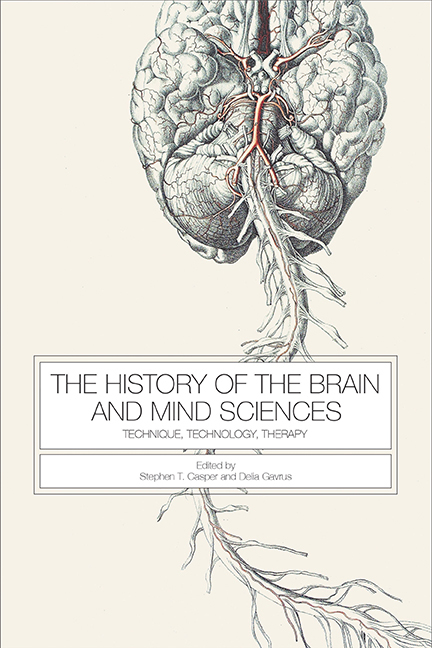Book contents
- Frontmatter
- Contents
- Acknowledgments
- Introduction
- 1 “We Are Veritable Animals”: The Nineteenth-Century Paris Menagerie as a Site for the Science of Intelligence
- 2 “Physiological Surgery”: Laboratory Science as the Epistemic Basis of Modern Surgery (and Neurosurgery)
- 3 Configuring Epidemic Encephalitis as a National and International Neurological Concern
- 4 Circuits, Algae, and Whipped Cream: The Biophysics of Nerve, ca. 1930
- 5 Epilepsy and the Laboratory Technician: Technique in Histology and Fiction
- 6 “What Was in Their Luggage?”: German Refugee Neuroscientists, Migrating Technologies, and the Emergence of Interdisciplinary Research Networks in North America, 1933 to 1963
- 7 Dualist Techniques for Materialist Imaginaries: Matter and Mind in the 1951 Festival of Britain
- 8 A “Model Schizophrenia”: Amphetamine Psychosis and the Transformation of American Psychiatry
- 9 Salvation through Reductionism: The National Institute of Mental Health and the Return to Biological Psychiatry
- Coda: Technique, Marginality, and History
- Bibliography
- List of Contributors
- Index
6 - “What Was in Their Luggage?”: German Refugee Neuroscientists, Migrating Technologies, and the Emergence of Interdisciplinary Research Networks in North America, 1933 to 1963
Published online by Cambridge University Press: 26 May 2021
- Frontmatter
- Contents
- Acknowledgments
- Introduction
- 1 “We Are Veritable Animals”: The Nineteenth-Century Paris Menagerie as a Site for the Science of Intelligence
- 2 “Physiological Surgery”: Laboratory Science as the Epistemic Basis of Modern Surgery (and Neurosurgery)
- 3 Configuring Epidemic Encephalitis as a National and International Neurological Concern
- 4 Circuits, Algae, and Whipped Cream: The Biophysics of Nerve, ca. 1930
- 5 Epilepsy and the Laboratory Technician: Technique in Histology and Fiction
- 6 “What Was in Their Luggage?”: German Refugee Neuroscientists, Migrating Technologies, and the Emergence of Interdisciplinary Research Networks in North America, 1933 to 1963
- 7 Dualist Techniques for Materialist Imaginaries: Matter and Mind in the 1951 Festival of Britain
- 8 A “Model Schizophrenia”: Amphetamine Psychosis and the Transformation of American Psychiatry
- 9 Salvation through Reductionism: The National Institute of Mental Health and the Return to Biological Psychiatry
- Coda: Technique, Marginality, and History
- Bibliography
- List of Contributors
- Index
Summary
Introduction
Technique and technologies in the neurosciences and psychiatry are not only locally developed, but have been historically subjected to the political, contingent, and adaptive living and working contexts of their bearers: neuroscientists and psychiatrists themselves. This essay will explore the particularly disruptive context of the forced migration of neuroscientists from Central Europe under Nazi and Fascist occupation—including the migration of things and technologies and their often marginality and liminality. I map several developments related to this mass exodus in order to assess some of the influences that the forced migration process had on the formation of new neuroscientific networks that transformed existing neurological and psychiatric research communities on the other side of the Atlantic. In this way, we can gain insight into intricate relationships among the techniques, technologies, and diagnostic “repertoires as techniques of manipulation,”which stimulated the development of neuroscientific research in the postwar period, a phase in which the modern neurosciences increasingly became an interdisciplinary technical field. The processes of “mobilization,” “transfer,” and “(re)integration” of research and diagnostic technologies were crucial for enabling researchers to work in new neuroscientificlaboratories and clinical settings. Yet at the same time, such processes also threatened the security of researcher identities.
In the 1930s, hundreds of German-speaking refugees trained in neurology, psychiatry, and neuropathology integrated into preexisting neuroscientific communities in Canada and the United States. The year 1933 in particular marked a time when groundbreaking political changes occurred with the Nazis’ rise to power in Germany. The Law for the Reestablishment of a Professional Civil Service (Gesetz zur Wiederherstellung des Berufsbeamtentums), enacted on April 7, 1933, deeply affected the scientists working in the mind and brain sciences. The situation further deteriorated with the establishment of the Nuremberg Race Laws on September 15, 1935, when thousands of medical doctors and scientists— mostly of Jewish descent—were driven from their governmentsupported offices.
- Type
- Chapter
- Information
- The History of the Brain and Mind SciencesTechnique, Technology, Therapy, pp. 164 - 182Publisher: Boydell & BrewerPrint publication year: 2017

